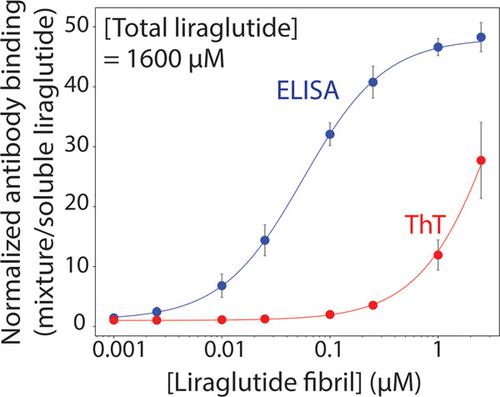当前位置:
X-MOL 学术
›
Biotechnol. Bioeng.
›
论文详情
Our official English website, www.x-mol.net, welcomes your
feedback! (Note: you will need to create a separate account there.)
Directed evolution of conformation‐specific antibodies for sensitive detection of polypeptide aggregates in therapeutic drug formulations
Biotechnology and Bioengineering ( IF 3.5 ) Pub Date : 2020-10-23 , DOI: 10.1002/bit.27610 Wenjia Lou 1, 2 , Samuel D Stimple 1, 2 , Alec A Desai 2 , Emily K Makowski 1 , Sibel Kalyoncu 3 , Jesper E Mogensen 4 , Lotte T Spang 4 , Désirée J Asgreen 4 , Arne Staby 4 , Karen Duus 4 , Jan Amstrup 4 , Yulei Zhang 2 , Peter M Tessier 1, 2, 3, 5
Biotechnology and Bioengineering ( IF 3.5 ) Pub Date : 2020-10-23 , DOI: 10.1002/bit.27610 Wenjia Lou 1, 2 , Samuel D Stimple 1, 2 , Alec A Desai 2 , Emily K Makowski 1 , Sibel Kalyoncu 3 , Jesper E Mogensen 4 , Lotte T Spang 4 , Désirée J Asgreen 4 , Arne Staby 4 , Karen Duus 4 , Jan Amstrup 4 , Yulei Zhang 2 , Peter M Tessier 1, 2, 3, 5
Affiliation

|
Biologics such as peptides and proteins possess a number of attractive attributes that make them particularly valuable as therapeutics, including their high activity, high specificity, and low toxicity. However, one of the key challenges associated with this class of drugs is their propensity to aggregate. Given the safety and immunogenicity concerns related to polypeptide aggregates, it is particularly important to sensitively detect aggregates in therapeutic drug formulations as part of the quality control process. Here, we report the development of conformation‐specific antibodies that recognize polypeptide aggregates composed of a GLP‐1 receptor agonist (liraglutide) and their integration into a sensitive immunoassay for detecting liraglutide amyloid fibrils. We sorted single‐chain antibody libraries against liraglutide fibrils using yeast surface display and magnetic‐activated cell sorting, and identified several antibodies with high conformational specificity. Interestingly, these antibodies cross‐react with amyloid fibrils formed by several other polypeptides, revealing that they recognize molecular features common to different types of fibrils. Moreover, we find that our immunoassay using these antibodies is >50‐fold more sensitive than the conventional method for detecting liraglutide aggregation (Thioflavin T fluorescence). We expect that our systematic approach for generating a sensitive, aggregate‐specific immunoassay can be readily extended to other biologics to improve the quality and safety of formulated drug products.
中文翻译:

用于敏感检测治疗药物制剂中多肽聚集体的构象特异性抗体的定向进化
肽和蛋白质等生物制剂具有许多吸引人的特性,使它们作为治疗剂特别有价值,包括它们的高活性、高特异性和低毒性。然而,与此类药物相关的主要挑战之一是它们的聚集倾向。鉴于与多肽聚集体相关的安全性和免疫原性问题,作为质量控制过程的一部分,灵敏地检测治疗药物制剂中的聚集体尤为重要。在这里,我们报告了构象特异性抗体的开发,这些抗体识别由 GLP-1 受体激动剂(利拉鲁肽)组成的多肽聚集体,并将它们整合到检测利拉鲁肽淀粉样蛋白原纤维的灵敏免疫测定中。我们使用酵母表面展示和磁激活细胞分选对利拉鲁肽原纤维的单链抗体库进行了分选,并鉴定了几种具有高构象特异性的抗体。有趣的是,这些抗体与由其他几种多肽形成的淀粉样原纤维交叉反应,表明它们识别不同类型原纤维共有的分子特征。此外,我们发现使用这些抗体的免疫测定比检测利拉鲁肽聚集的传统方法(硫黄素 T 荧光)灵敏 50 倍以上。我们希望我们用于产生灵敏的、聚合特异性免疫测定的系统方法可以很容易地扩展到其他生物制剂,以提高制剂产品的质量和安全性。并鉴定了几种具有高构象特异性的抗体。有趣的是,这些抗体与由其他几种多肽形成的淀粉样原纤维交叉反应,表明它们识别不同类型原纤维共有的分子特征。此外,我们发现使用这些抗体的免疫测定比检测利拉鲁肽聚集的传统方法(硫黄素 T 荧光)灵敏 50 倍以上。我们希望我们用于产生灵敏的、聚合特异性免疫测定的系统方法可以很容易地扩展到其他生物制剂,以提高制剂产品的质量和安全性。并鉴定了几种具有高构象特异性的抗体。有趣的是,这些抗体与由其他几种多肽形成的淀粉样原纤维交叉反应,表明它们识别不同类型原纤维共有的分子特征。此外,我们发现使用这些抗体的免疫测定比检测利拉鲁肽聚集的传统方法(硫黄素 T 荧光)灵敏 50 倍以上。我们希望我们用于产生灵敏的、聚合特异性免疫测定的系统方法可以很容易地扩展到其他生物制剂,以提高制剂产品的质量和安全性。揭示它们识别不同类型原纤维共有的分子特征。此外,我们发现使用这些抗体的免疫测定比检测利拉鲁肽聚集的传统方法(硫黄素 T 荧光)灵敏 50 倍以上。我们希望我们用于产生灵敏的、聚合特异性免疫测定的系统方法可以很容易地扩展到其他生物制剂,以提高制剂产品的质量和安全性。揭示它们识别不同类型原纤维共有的分子特征。此外,我们发现使用这些抗体的免疫测定比检测利拉鲁肽聚集的传统方法(硫黄素 T 荧光)灵敏 50 倍以上。我们希望我们用于产生灵敏的、聚合特异性免疫测定的系统方法可以很容易地扩展到其他生物制剂,以提高制剂产品的质量和安全性。
更新日期:2020-10-23
中文翻译:

用于敏感检测治疗药物制剂中多肽聚集体的构象特异性抗体的定向进化
肽和蛋白质等生物制剂具有许多吸引人的特性,使它们作为治疗剂特别有价值,包括它们的高活性、高特异性和低毒性。然而,与此类药物相关的主要挑战之一是它们的聚集倾向。鉴于与多肽聚集体相关的安全性和免疫原性问题,作为质量控制过程的一部分,灵敏地检测治疗药物制剂中的聚集体尤为重要。在这里,我们报告了构象特异性抗体的开发,这些抗体识别由 GLP-1 受体激动剂(利拉鲁肽)组成的多肽聚集体,并将它们整合到检测利拉鲁肽淀粉样蛋白原纤维的灵敏免疫测定中。我们使用酵母表面展示和磁激活细胞分选对利拉鲁肽原纤维的单链抗体库进行了分选,并鉴定了几种具有高构象特异性的抗体。有趣的是,这些抗体与由其他几种多肽形成的淀粉样原纤维交叉反应,表明它们识别不同类型原纤维共有的分子特征。此外,我们发现使用这些抗体的免疫测定比检测利拉鲁肽聚集的传统方法(硫黄素 T 荧光)灵敏 50 倍以上。我们希望我们用于产生灵敏的、聚合特异性免疫测定的系统方法可以很容易地扩展到其他生物制剂,以提高制剂产品的质量和安全性。并鉴定了几种具有高构象特异性的抗体。有趣的是,这些抗体与由其他几种多肽形成的淀粉样原纤维交叉反应,表明它们识别不同类型原纤维共有的分子特征。此外,我们发现使用这些抗体的免疫测定比检测利拉鲁肽聚集的传统方法(硫黄素 T 荧光)灵敏 50 倍以上。我们希望我们用于产生灵敏的、聚合特异性免疫测定的系统方法可以很容易地扩展到其他生物制剂,以提高制剂产品的质量和安全性。并鉴定了几种具有高构象特异性的抗体。有趣的是,这些抗体与由其他几种多肽形成的淀粉样原纤维交叉反应,表明它们识别不同类型原纤维共有的分子特征。此外,我们发现使用这些抗体的免疫测定比检测利拉鲁肽聚集的传统方法(硫黄素 T 荧光)灵敏 50 倍以上。我们希望我们用于产生灵敏的、聚合特异性免疫测定的系统方法可以很容易地扩展到其他生物制剂,以提高制剂产品的质量和安全性。揭示它们识别不同类型原纤维共有的分子特征。此外,我们发现使用这些抗体的免疫测定比检测利拉鲁肽聚集的传统方法(硫黄素 T 荧光)灵敏 50 倍以上。我们希望我们用于产生灵敏的、聚合特异性免疫测定的系统方法可以很容易地扩展到其他生物制剂,以提高制剂产品的质量和安全性。揭示它们识别不同类型原纤维共有的分子特征。此外,我们发现使用这些抗体的免疫测定比检测利拉鲁肽聚集的传统方法(硫黄素 T 荧光)灵敏 50 倍以上。我们希望我们用于产生灵敏的、聚合特异性免疫测定的系统方法可以很容易地扩展到其他生物制剂,以提高制剂产品的质量和安全性。










































 京公网安备 11010802027423号
京公网安备 11010802027423号